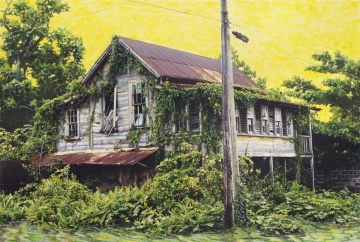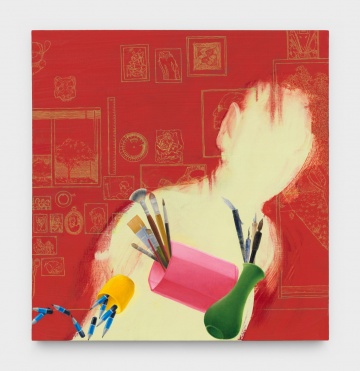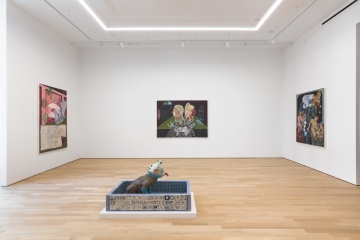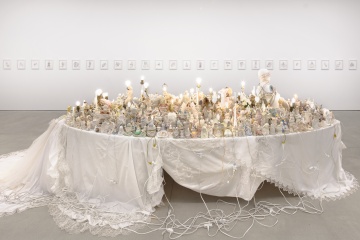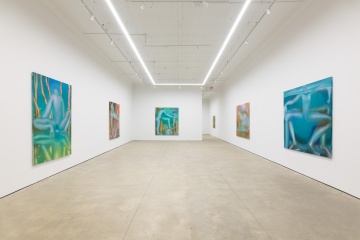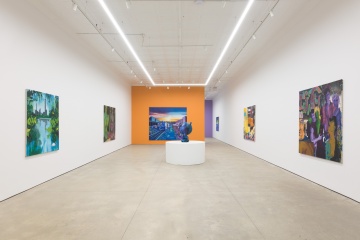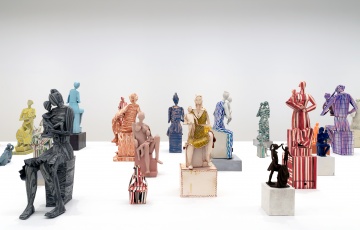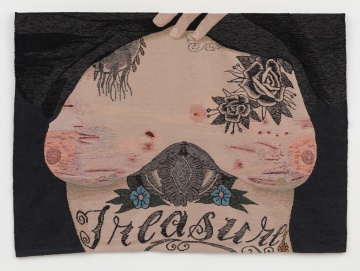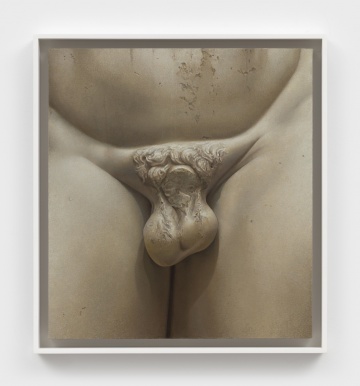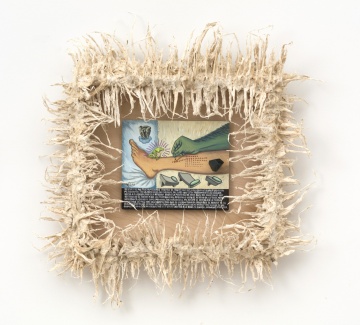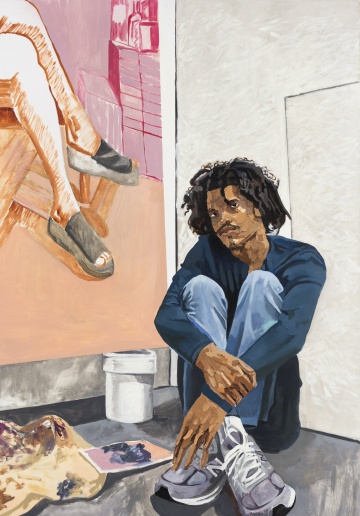P•P•O•W
392 Broadway
New York, NY 10013
212 647 1044
Also at:
390 Broadway, 2nd Floor
New York, NY 10013
212 647 1044
New York, NY 10013
212 647 1044
Also at:
390 Broadway, 2nd Floor
New York, NY 10013
212 647 1044
P·P·O·W was founded by Wendy Olsoff and Penny Pilkington in the first wave of the East-Village Art Scene in New York City in 1983. The gallery moved to Soho in 1988, moved to Chelsea in 2002, and in 2021 moved to its current space in Tribeca. P·P·O·W maintains a diverse roster of national and international artists. Since its inception, the gallery has remained true to its early vision, showing contemporary work in all media.
Artists Represented:
The Estate of Martin Wong
The Estate of Carolee Schneemann
The Estate of David WojnarowiczThe Estate of Martin Wong
Ann Agee
Karen Arm
Dotty Attie
George Boorujy
Elijah Burgher
Kyle Dunn
Chris Daze Ellis
Aaron Gilbert
Elizabeth Glaessner
Ben Gocker
Jay Lynn Gomez
Hilary Harkness
Joe Houston
Clementine Keith-Roach
Sanam Khatibi
Katherine Kuharic
Dinh Q. Le
Judith Linhares
Hew Locke
Gerald Lovell
Guadalupe Maravilla
Carlos Motta
Portia Munson
Adam Putnam
Hunter Reynolds
Erin M. Riley
Annabeth Rosen
Allison Schulnik
Jessica Stoller
Chiffon Thomas
Betty Tompkins
Suzanne Treister
Anton van Dalen
Robin F. Williams
Martha Wilson




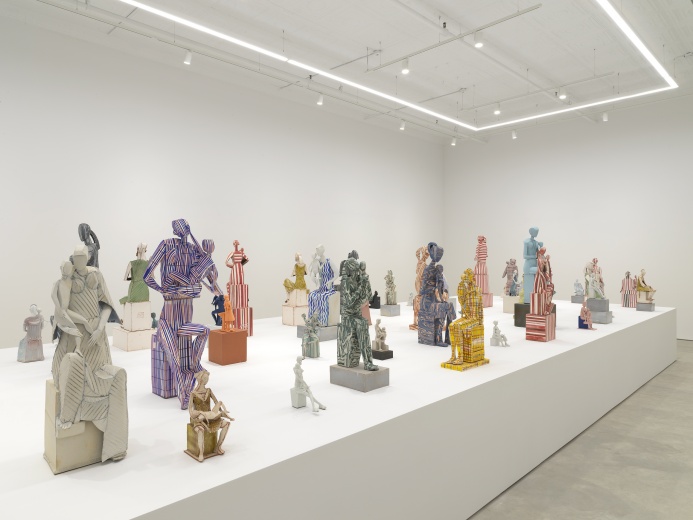
Installation view: Gerald Lovell, "all that I have", January 22 - February 20, 2021
Installation view: Guadalupe Maravilla, "Seven Ancestral Stomachs", February 26-March 27, 2021
Installation view: Martin Wong & Aaron Gilbert, "1981-2021", April 2 - May 1, 2021
Installation view: Erin M. Riley, "The Consensual Realities of Healing Fantasies", May 7 - June 12, 2021
Installation view: Ann Agee, "Madonnas and Hand Warmers", June 18 - July 23, 2021

Kate Kuharic
The Foliated Room
December 15, 2023 - January 27, 2024

Carolee Schneemann
Of Course You Can/Don't You Dare
November 17, 2023 - December 22, 2023
Daniel Correa Mejia
Soy el dueño de mis casa
October 27, 2023 - December 9, 2023

Hilary Harkness
Prisoners from the Front
October 13, 2023 - November 11, 2023
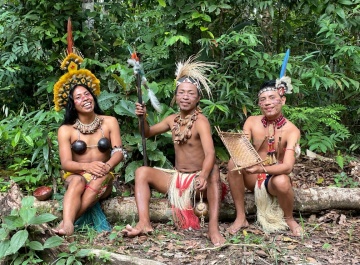
Carlos Motta with Elio Miraña, ELO, Gil Farekatde Maribba, Higinio Bautista, Kiyedekago, Rosita, and Yoí nanegü
Jjagɨyɨ: Air of Life
September 8, 2023 - October 7, 2023

Harry Gould Harvey IV
Sick Metal
June 29, 2023 - August 4, 2023
Dotty Attie
What Surprised Them Most
June 9, 2023 - August 4, 2023
P·P·O·W is pleased to present What Surprised Them Most, Dotty Attie’s eleventh solo exhibition with the gallery. Featuring major works from 1974 to 2023, this exhibition marks the first survey of Attie’s practice. For nearly six decades, Attie has rigorously engaged the grid as a formal and conceptual tool, masterfully rendering her small-scale drawings and canvases to create cadenced arrangements that disrupt the accepted art historical canon. From her earliest drawings to her more recent paintings,What Surprised Them Most highlights Attie’s lifelong dedication to recontextualizing sourced images with unique text, exhibiting a profoundly original body of work that questions societal conventions and reveals to the viewer “the parts of ourselves that we don’t really share with anybody else.”
Dana DeGiulio
Opening
May 18, 2023 - June 24, 2023
P·P·O·W is pleased to present Opening, Dana DeGiulio’s first solo exhibition with the gallery. In Opening, DeGiulio presents 80 perceptual paintings made at home next to the window as an iterative project that began in 2013. The object of attention of each is a bunch of cheap dead roses at rest on the radiator.
Shellyne Rodriguez
Third World Mixtapes: The Infrastructure of Feeling
March 17, 2023 - April 22, 2023
Hew Locke
Listening to the Land
February 24, 2023 - April 1, 2023
P·P·O·W is pleased to present Listening to the Land, Hew Locke’s second solo exhibition with the gallery. Locke is known for exploring the languages of colonial and post-colonial power, and the symbols through which different cultures assume and assert identity. Furthering the themes explored in his celebrated commission The Procession at Tate Britain, and his concurrent installation Gilt on the façade of the Metropolitan Museum of Art, this exhibit engages with contemporary and historical inequities while reflecting on the landscape and history of the Caribbean. The exhibition draws its title from a poem by Guyanese political activist and poet Martin Carter which situates itself between two opposing forces of the landscape – sea and forest. Locke’s show features new sculptures and wall works with recurring motifs of stilt-houses, boats, memento mori, and share certificates referencing tensions between the land, the sea, and economic power. Reflecting on these links, Locke notes, “The land was created to generate money for colonial power, now the sea wants it back.”
Tom Knechtel
Drawn After Life
February 3, 2023 - March 11, 2023
P·P·O·W is pleased to present Drawn After Life, an exhibition of paintings and drawings by Tom Knechtel. Known for his complex allegorical narratives using a repertoire of characters and exploring themes of sexuality, animal nature, and the fragility of the human body, Knechtel’s work pushes an unflinching vulnerability to boldly confront his lived reality. Ebbing between opulent, saturated colors and stark, somber hues, Drawn After Life surveys an emotional tide, vacillating between the sited and psychic, the observed and imagined.
Jimmy DeSana
The Dungeon Series, 1978-79
February 3, 2023 - February 11, 2023
P·P·O·W is pleased to present Jimmy DeSana: The Dungeon Series, 1978-79, an exhibition showcasing one of the artist’s earliest bodies of work, conceived and executed in close collaboration with the author and dominatrix Terence Sellers. This show marks the gallery’s first exhibition of DeSana’s photography since taking on representation of the artist’s estate in 2022, and coincides with Jimmy DeSana: Submission, the first major institutional retrospective of DeSana’s work, currently on view at the Brooklyn Museum.
Adam Putnam
Holes
January 20, 2023 - February 18, 2023
P·P·O·W is pleased to present Holes, Adam Putnam’s fourth solo exhibition with the gallery. Through the building up of imagery by means of photography, drawing, sculpture, film, and performance, Adam Putnam continues an ongoing exploration of the boundaries between architecture, nature, the physical and the internal self, often using one as a stand in for the other.
Anton Van Dalen
Doves: Where They Live and Work
December 9, 2022 - January 28, 2023
“van Dalen’s ongoing practice is proof that the most important and galvanizing ideas can be forged and nurtured outside of the mainstream. An effort through which one builds a family of friends and allies. A community of many.”
- Tiernan Morgan, Artists Living in Cities, 2022
P·P·O·W is pleased to present Doves: Where They Live and Work, Anton van Dalen’s third solo exhibition with the gallery. Since moving to New York in 1966, and settling in the East Village, van Dalen has served as witness, storyteller, and documentarian of the dramatic cultural shifts in the neighborhood, through his masterfully honed and singular iconography. As critic John Yau writes in his essay for the recently published monograph, Anton van Dalen: Community of Many, “van Dalen’s work arises out of a meticulous draftsmanship in service of an idiosyncratic imagination merged with civic-mindedness.”[2] Bringing together new and historical works, Doves: Where They Live and Work juxtaposes van Dalen’s lifelong commitment to exposing inequality amidst the societal influences of technology, war, and capitalism with his personal and artistic dedication to the lives of the white pigeons who have lived on his East Village roof since 1971.
Allison Schulnik
Purple Mountain
November 4, 2022 - December 10, 2022
P·P·O·W is pleased to present Purple Mountain, Allison Schulnik’s second solo exhibition with the gallery. Known for her uncanny approach to traversing the internal and immaterial terrains of nostalgia, memories, and dreams, Purple Mountain blurs the line between reality and fantasy to create a mystical portrait of home and motherhood within the stark desert landscape of Southern California. Born out of the seclusion of COVID, the challenges of living in a growingly inhospitable desert terrain, and experiences of deep personal loss, Schulnik’s new series of paintings, works on paper, and animated film reflects a coalescing of worlds where fear, mortality, and loss are met equally with resilience, interconnectedness, and the spiritual power of the natural world.
Chiffon Thomas
Staircase to the Rose Window
September 9, 2022 - October 15, 2022
“The room is scorching. Dormant vents, aged columns, bodies drawn in thread all emanate heat. Fire is amiss, yet ashy paths hint blazes of yore. A yearning flame or a flared want, Chiffon Thomas’ vignettes and sculptures condense desires- achieved, failed, or suspended.”
- Osman Can Yerebakan
P·P·O·W is pleased to present Staircase to the Rose Window, Chiffon Thomas’ first solo exhibition with the gallery. Synthesizing embroidery, collage, drawing, and sculpture, Thomas’ practice contends with the crafted body to examine wider issues of gender, race, sexuality and institutional power. Forcefully eschewing easy classification, Thomas’ “impossible bodies” embrace the space between figuration and abstraction. With an intuitive application of utilitarian and industrial materials, Thomas creates a visual language for translating both cultural narratives and personal experiences which push toward tangible forms of healing. Inspired by science fiction authors such as Octavia Butler, childhood memories, and his own physical experience of transformation, Thomas’ Staircase to the Rose Window transports the viewer to a dystopian world that allegorizes the quest for satisfaction in the face of persistent longing.
On the South Side of Chicago, amid the Bronzeville community’s sprawling public housing units, Thomas remembers childhood encounters with an incongruously gothic rose window towering above the complex’s main courtyard. No matter how many steps he climbed, the window was always just out of reach, its hazy oculus becoming an inaccessible portal, encapsulating unrequited promises of transformation, desire, and possibility. As Thomas notes, “this idea of being transformed foregrounds the cosmetic upgrades my own body has endured over the past decade. My body is that of a trans person; a culmination of hormones, haircuts, scars, muscle and fat redistribution, presentation, and demeanor, that subtly shift the way the world perceives me and the way I perceive myself within the world. I have watched my body reconfigure itself only to reach a state of relief, comfort, or contentment. In doing so, I have also grieved parts of my body that I have had to detach from physically and mentally.” In Staircase to the Rose Window, Thomas physicalizes these emotions and experiences in a parallel post-apocalyptic world: a hot, inhospitable desert filled with the detritus from a pre-existing civilization. Amid discarded box fans, rusted hardware, and peeling columns, a central figure wanders within an inconclusive loop under the watchful eyes of rose-window-adorned-towers.
“History is slanted, but Thomas can write his own story.”1 In Staircase to the Rose Window, Thomas makes pliable the social, political, and religious institutions once considered rigid and impenetrable. In Rose Window Tower, 2022, Thomas burns, welds, and transforms forgotten architectural elements such as wooden columns and tin ceiling panels to reconstruct designs of a former society and its hierarchical social systems. The sculpture’s woven tin and steel dome rises above the landscape, operating as both surveillance tool and gateway. In an ongoing new series also on view, Thomas reconstructs Christian Bible covers into a series of “Bible houses” each named after specific Chicago public housing communities. Grappling with experiences of growing up within Jehovah's Witnesses, Thomas’ delicately sown and suspended miniature structures pay homage to the fervent religious communities on the South Side of Chicago by harnessing a resourceful materiality, revealing the simultaneous vulnerability and power required to uphold communities, cultures and identities.
A trained percussionist, Thomas will combine sculpture and sound for the first time, activating several of the sculptures throughout the exhibition with an ambient score. A performance by the artist will begin at 7pm opening night.
Staircase to the Rose Window will be accompanied by a catalogue featuring an essay by curator and art writer Osman Can Yerebakan.
Born in Chicago, IL, Chiffon Thomas (b. 1991) holds an MFA from Yale University and a BFA from The School of The Art Institute of Chicago. Thomas has been included in exhibitions at the Institute of Contemporary Art, Miami, FL; Sculpture Center, Long Island City, NY; P·P·O·W, New York, NY; Kohn Gallery, Los Angeles, CA; Kavi Gupta, Chicago, IL; Galerie Perrotin, Tokyo, Japan; and the Currier Museum of Art, Manchester, NH, among others. Thomas has completed prominent residencies with the Skowhegan School of Painting and Sculpture, Skowhegan, ME and the Fountainhead Residency, Miami, FL. His work is in the permanent collections of the Hammer Museum, Los Angeles, CA; Institute of Contemporary Art, Miami, FL; Pérez Art Museum, Miami, FL; X Museum, Beijing, China; Norton Museum of Art, West Palm Beach, FL; and the Currier Museum of Art, Manchester, NH; among others. In September 2023, Thomas will present his first solo museum exhibition at the Aldrich Museum of Contemporary Art, Ridgefield, CT.
Astrid Terrazas
La Jardinera
September 9, 2022 - October 22, 2022
P·P·O·W is pleased to present La Jardinera, Astrid Terrazas’ first solo exhibition with the gallery. Taking the form of mixed media painting and ceramic sculpture, Terrazas’ illustrative, highly detailed, and symbolic practice re-writes worlds. Influenced by surrealist artists such as Remedios Varo and folk artists such as Minnie Evans, Terrazas’ paintings are filled with transient, often zoomorphic figures, idiosyncratic iconographies, and illogical narratives. With unflinching vulnerability, Terrazas merges dreamscapes, Mexican ancestral folklore, personal experiences, and unearthly transfigurations to create spaces for communal healing, protection, and metamorphosis. Featuring a new series of paintings and Terrazas’ first ever large-scale ceramic fountain, La Jardinera presents an alternative, sacred space honoring duality and upholding ideals of empathy and reciprocity.
Informed by the geography of her childhood, Terrazas contends with borders both physical and psychological. Born in Juarez, Mexico, she regularly crossed the border into El Paso, Texas to go to her favorite stores or to help family members shop for groceries. This fluid relationship was abruptly curbed when, at the age of seven, Terrazas and her parents were forced to leave Mexico and relocate to Dallas, Texas. Cut off from her extended family in Mexico, Terrazas felt rootless but never lost her sense of living in two cultures. In How many love tokens went missing in Mexico, 2022, Terrazas recalls memories of sending her uncle clothing from the United States that was unavailable in Mexico. Recently deceased, her uncle is portrayed as an angel, couched within a fantastical landscape of Juarez and a vision of her grandmother’s apartment set in front of a backdrop of mountains which are simultaneously a herd of giant cows. By sending her uncle gifts, Terrazas was able to transcend the bounds of time and space, and through the process of painting these memories, she also crosses the borders between life and death to reach him.
For Terrazas, painting is “a process of finding and burying” akin to incanting, a way to cast spells and weave new remedial narratives to transmute histories. Throughout the exhibition, Terrazas employs the symbol of a fountain to challenge the traditional power structures directing the flow of giving and restricting individual capacity for reciprocity and regeneration. Looking specifically at the Rio Grande’s natural divide between the United States and Mexico, Terrazas questions what could have been if such a waterway had been used to nurture both countries instead of sowing divisiveness. Drawing a direct parallel to this body of water, Terrazas highlights the way fountains in cities become symbols of power and access for the few through the exploitation of resources intended for all. In Fountains, can I build one, be one?, 2021, Terrazas depicts herself as a stone fountain with water flowing through her to fill an empty, dried out basin. Grappling with personal and inherited trauma, Terrazas reveals how individuals can take on the power of a fountain and become sites of radical empathy and abundant replenishment.
Translating to “gardener” or “flowerbed,” Terrazas describes the paintings in La Jardinera as seeds. Beginning as investigations into reoccurring phrases or mantras which would become lodged within Terrazas’ subconscious often coming to her in dreams, the paintings became portals populated by various guardian figures who could guide Terrazas towards healing and transformation. Just as a garden is able to grow and flourish, these paintings both nurture La Jardinera and are nurtured by the exhibition’s central ceramic fountain, La Fuente (para Sydney), 2022. A sphinx-like creature with the contemporary clothing of a young woman, the fountain’s pomegranate mouth acts as a nozzle from which water flows into a basin of hand painted, carved, and cut tiles ornamented with Terrazas’ unique cast of reoccurring hybrid characters of angels-devils and human-animals. A wishing fountain, Terrazas invites visitors to write down their wishes and throw them into the fountain. While wishes are usually kept secret, Terrazas believes it is important to make our wishes, desires, and hopes known in order for us to grow together as a community. Neither inside nor outside, good nor evil, human nor non-human, American nor Mexican, La Jardinera holds multiple truths at once, providing a framework for how individuals and society can gain the capacity to become regenerative fountains for giving.
Astrid Terrazas (b. 1996) received her BFA in Illustration from Pratt Institute in 2018 and lives and works in Queens, New York. She has exhibited work at P·P·O·W, New York, NY; Lyles & King, New York, NY; Nicodim Gallery, New York, NY; Y2K Group, New York, NY; Andrea Festa Fine Art, Rome, Italy; Marinaro, New York, NY; Fort Makers, New York, NY; Gern en Regalia, New York, NY; Front Gallery, Houston, TX; and 98 Orchard St, New York, NY; among others. Her work has recently been featured in articles in Art Maze Mag, The Art Newspaper, and The Brooklyn Rail and is currently on view in 52 Artists: A Feminist Milestone at the Aldrich Contemporary Museum of Art through January 8, 2023.
Portia Munson
Bound Angel
July 7, 2022 - August 19, 2022
P·P·O·W is pleased to present Bound Angel, a solo exhibition of new works by Portia Munson. For over three decades, Munson has created maximal installations, sculptures, paintings, and digital prints using a vast accumulation of ready-made consumer products to decipher the latent cultural codes embedded in mass-produced items. Combing through second-hand stores, yard sales, and flea markets, Munson collects hundreds of objects, each one a surrogate for the thousands just like it around the world. Furthering this decades-long investigation, Bound Angel examines the impact of mass production on the formation of identity and the resulting connection between the ongoing struggle for gender equality and the mounting ecological crisis.
Building upon her pivotal Pink Project Table, originally exhibited in Marcia Tucker’s historic Bad Girls exhibition at the New Museum in 1994, the exhibition’s largest sculpture and namesake, Bound Angel, features discarded objects in the shape of female angels, including figurines of small girls, the Virgin Mary, classical and pornographic nudes, snow globes, candle holders, nightlights, lamps, soap dispensers, and more. Organized on an immense oval dining table covered in a tablecloth composed of used wedding dresses, the entire sculpture forms the shape of a bound and faceless bride. Beginning with the cords of the lamps, Munson began binding many of the objects, blinding, stifling, and entangling them to reveal the violence and terror lurking under the surface. Munson’s new series of Serving Trays, ceramic and glass figurines tied up with string and amassed on elegant, anachronistic silver platters, will flank this monumental installation. Together, both Bound Angel and the Serving Tray series act as sacrificial martyrs, inviting the contemplation of what we are being fed as a culture and who ultimately pays for it.
Along with Bound Angel, Munson includes another large-scale sculpture in the shape of a female form. In Today Will Be Awesome, 2022, Munson includes the top half of a headless pink mannequin, arms folded to the hip in a power stance and wearing pink elbow pads, back-pack, a large ribbon with the words FEMINIST printed on it, and a pink plastic pearl necklace. Thousands of amassed pink objects produced to appeal to women and girls including figurines, dolls, beauty products, fake hair, fake flowers, dresses, bras, tiaras, evening gloves, jewelry, awards, and more form the figure’s large hoop skirt, opened at the front to reveal everything she has to offer. At her base is a sign, made for a woman’s desk, stating “Today Will be Awesome.” In front of the sign lies a curled-up figurine on its side, her hands pressing against her pelvis in the fetal position. While the individual objects in Today Will Be Awesome, 2022, were manufactured to sell confidence, positivity, and success to young women, Munson’s accumulation of them exposes their suffocation, violence, and victimization.
In addition to the new sculptures, Bound Angel will also feature painted and drawn still life meditations on individual objects found within Munson’s installations. In 50 drawings from her Functional Women series, Munson focuses on objects which exaggerate the female form such as spread legs nutcracker, ash tray, bare breasted mug, female torso perfume bottle, naked bottle opener, and lewd salt and pepper shakers. Munson’s paintings and drawings underscore her genuine fascination and care for the objects she collects, and her desire to discover and record their messages. Taken together, the works which make up Bound Angel, act as a living archive documenting the ways women’s lives and bodies are controlled and manipulated. Bound Angel reviles the insatiable, consumerist, sexist, and repressive value systems which degrade society and destroy the environment. By bringing these objects together, Munson harnesses their collective power, transforming their original function to pacify, sexualize, and infantilize women into one of retaliation, confrontation, and strength.
Portia Munson (b.1961) lives and works in Catskill, NY. She holds a BFA from Cooper Union, an MFA from Rutgers University, and studied at the Skowhegan School and Painting and Sculpture. She has been awarded residencies at institutions including Civitella Ranieri, Umbertide, Italy; MacDowell Colony for the Arts, Peterborough, NH; Fine Arts Work Center, Provincetown, MA; and Yaddo, Saratoga Springs, NY. Munson was awarded a Pollock-Krasner Foundation Grant in 2019. Her work has been the subject of over twenty solo exhibitions at P·P·O·W, New York, NY; White Columns, New York, NY; MASS MoCA, North Adams, MA; Bedford Gallery, Walnut Creek, CA; and Olana State Historic Site, Hudson, NY, among others. Munson’s work has also included in numerous international group exhibitions including Still, Life! Mourning, Meaning, Mending, 21c Louisville, Louisville, KY; Cross Pollination: Heade, Cole, Church, and our Contemporary Moment, Olana State Historic Site, Hudson, NY; Dime-Store Alchemy, curated by Jonathan Rider, FLAG Art Foundation, New York, NY; Beyond Boundaries: Feminine Forms, Pennsylvania Academy of the Fine Arts, Philadelphia, PA; Objectophilia; Biennial of the Americas, Museum of Contemporary Art, Denver, CO; and Bad Girls, curated by Marcia Tucker, New Museum of Contemporary Art, New York, NY, among others. Her public works include Pink Projects with the Art Production Fund, Rockefeller Center, New York, NY; Art in the Terminal, the Albany International Airport, Albany, NY; MTA Arts for Transit, Bryant Park MTA Station, New York, NY; and a permanent Metropolitan Transit Authority installation in Brooklyn, NY. Munson’s work is currently on view in Memento Mori, a solo exhibition at Pamela Salisbury Gallery, Hudson, NY, and Portia Munson: Flood, an immersive installation at Art Omi, a gallery and sculpture park in Ghent, New York.
David Wojnarowicz
Dear Jean Pierre: The David Wojnarowicz Correspondence with Jean Pierre Delage, 1979-1982
March 25, 2022 - April 23, 2022
P·P·O·W is pleased to present Dear Jean Pierre: The David Wojnarowicz Correspondence with Jean Pierre Delage, 1979-1982, an exhibition showcasing the archive of Jean Pierre Delage, a lover of the late artist David Wojnarowicz, with whom Delage engaged in constant correspondence from 1978 to 1982. The nearly 300 letters, postcards, drawings, Xeroxes, and photographs on view comprise Delage’s archive of this period, and this presentation marks the first time the archive has been shown publicly in its entirety. A forthcoming catalogue of these materials will be published by Primary Information in 2023. Truly a foundational moment for Wojnarowicz’s artistic and literary practice, these letters to Delage not only reveal Wojnarowicz’s captivating personality—and its concomitant compassion, neurosis, and tenderness—but also index the development of the artist’s visual language that would go on to codify Wojnarowicz as one of the preeminent artists of his generation.
On the day of his twenty-fourth birthday in 1978, Wojnarowicz landed in Paris with ex-pat dreams. He intended to live in his sister’s studio apartment, master the French language, learn to play guitar, and write a novel. While none of these goals came to fruition, Wojnarowicz did meet Delage only two months into his stay, an encounter that would lead to a romantic relationship that Wojnarowicz considered his first true love. The pair quickly cemented their bond, with Wojnarowicz almost immediately moving into Delage’s apartment, and the two taking trips to the French countryside up until Wojnarowicz’s departure from Paris in June 1979.
Upon his return to New York, Wojnarowicz continued living and working in his customary fashion: he moved apartments often, cruised at the piers, and held odd jobs. Simultaneous to the humdrum, several significant events occurred that would come to typify Wojnarowicz’s oeuvre. He found work at an ad agency where he used a photostat machine to create his iconic Rimbaud mask (1979); he played in the no wave band 3 Teens Kill 4 (1980); he had his photographs published for the first time in Soho News and Little Cesar (1980); he met his most important mentor and eventual muse, the photographer Peter Hujar (1981); he began using stencils and graffiti to propagate his imagery throughout the burgeoning East Village (1981); he transposed his painted visual language onto the city’s abandoned piers (1981); and he published Sounds in the Distance, his first book of collected monologues (1982). Coinciding with these personal accomplishments, a then-unnamed disease began appearing in the artist’s community, with the New York Times reporting in July 1981: “Rare Cancer Seen in 41 Homosexuals”.
So, while Wojnarowicz’s postcards and letters to Delage function as a marker of the quotidian—often detailing the weather, workplace annoyances, roommate tiffs—taken as a whole, they reveal an artist becoming increasingly entrenched in, and vocal about the subjects that undergird much of his later practice: the outsider, the iconoclast, the dreamer, the mythmaker. In fact, Wojnarowicz would come to use many photographs, prints, and collages from this period in some of his most famous works, including several on view here: Untitled (Genet after Brassai), 1979; Untitled (Burning House), 1982; and Time, 1982.
Wojnarowicz’s letters to Delage document these momentous occasions and professional successes in the former’s life. But more importantly, they offer a never-before-seen image of Wojnarowicz as he navigates the liminal stage between discovering his passions and communicating those fascinations with the world around him.
David Wojnarowicz (1954-1992) has been included in solo and group exhibitions at The Museum of Modern Art, New York; Museum of Contemporary Art, Chicago; The American Center, Paris, France; The Busan Museum of Modern Art, Korea; Centro Galego de Art Contemporanea, Santiago de Compostela, Spain; The Barbican Art Gallery, London; and the Museum Ludwig, Cologne. His work is in permanent collections of major museums internationally and his life and work have been the subject of significant scholarly studies. Wojnarowicz has had retrospectives at the galleries of the Illinois State University, curated by Barry Blinderman, 1990, and at the New Museum, curated by Dan Cameron, 1999. A third retrospective, David Wojnarowicz: History Keeps Me Awake at Night, co-curated by David Kiehl and David Breslin, opened at the Whitney Museum of American Art in July 2018. The widely acclaimed exhibition traveled to the Museo Reina Sofia, Madrid in May 2019, and the Musee d/Art Moderne Grand-Duc Jean, Luxembourg City in November 2019. A concurrent exhibition of Wojnarowicz’s films and photographs opened at the KW Berlin in 2019. Wojnarowicz: Fuck You Faggot Fucker, a comprehensive feature-length documentary directed by Chris McKim, premiered in November 2020 and was named one of 2021’s best documentaries by Rolling Stone, The New Yorker, Esquire, and IndieWire, among others. A forthcoming catalogue of Wojnarowicz’s correspondence with Jean Pierre Delage will be published by Primary Information in 2023.
Cynthia Carr (b. 1950) is the author, most recently, of Fire in the Belly: The Life and Times of David Wojnarowicz (2012), winner of a Lambda Literary Award for “Gay Memoir/Biography’’ and finalist for the J. Anthony Lukas Book Prize awarded by Columbia Journalism School and the Nieman Foundation at Harvard University. Her previous books are Our Town: A Heartland Lynching, a Haunted Town, and the Hidden History of White America (2006) and On Edge: Performance at the End of the Twentieth Century (1993; re-issued in 2008 in a revised second edition). Carr chronicled the work of contemporary artists as a Village Voice staff writer in the 1980s and 1990s (under the byline C.Carr). Her work has also appeared in Artforum, Bookforum, The New York Times, TDR: The Drama Review, and other publications.
Anneliis Beadnell (b. 1983) is the Head Researcher and Archivist to the Estates of Carolee Schneemann, David Wojnarowicz, and Martin Wong. She received her MFA in Contemporary Art Theory from the University of Manchester, UK in 2009, before joining P·P·O·W as a Director in 2011. She has assisted in organizing such exhibitions as David Wojnarowicz: Photography & Film 1978-1992, KW Institute for Contemporary Art, Berlin, 2019; Soon All This Will be Picturesque Ruins: The Installations of David Wojnarowicz, P·P·O·W, New York, 2018; David Wojnarowicz: History Keeps Me Awake at Night, Whitney Museum of American Art, New York, 2018; and curated Martin Wong: Voices, P·P·O·W, New York, 2016; among others.
Elijah Burgher
Queen of the Forest
November 19, 2021 - December 22, 2021
P·P·O·W is pleased to present Queen of the Forest, Elijah Burgher's first solo exhibition with the gallery. Using painting
and drawing, Burgher works at the crossroads of representation and language, figuration, and abstraction, and the real
and imagined. Inspired by the literary and visual culture of the early 20th century occult revival and the reconstructed
paganism of the 1960s, Burgher’s Queen of the Forest synthesizes a variety of magical and artistic philosophies
regarding language, mythology, and desire to generate his highly personalized mystical iconography.
With a series of new, large-scale drawings, Burgher returns to in-depth figuration after five years cultivating a
remarkably intimate code of sigils, emblems, and abstraction. Drawing from mythology, ancient history, the occult, and
ritual magick, Burgher describes Queen of the Forest as being made “under the sign of Cybele.” Cut from equally scaled
rolls of watercolor paper, the drawings emphasize a freer mark-making and represent fragmentary notes for a temple
dedicated to the ancient archetypal dyad of the Mother Goddess and Son-Lover. Influenced by Robert Graves' The
White Goddess, Burgher’s Queen of the Forest examines the bond between this buried pagan relationship, specifically
the Mountain Goddess Cybele and her son and lover Attis, and its ties to sacred calendars and the cycles of nature.
Often pictured wearing a mural crown and riding a chariot drawn by two lions, Cybele, also known as the Magna
Mater or Great Mother, reifies nature in all its fecundity, sexuality, wonder, and violence. Accompanying this mythos is
Cybele’s son Attis, an agrarian deity in his own right who was ritually sacrificed in the spring by being hung from a pine
tree and castrated, his severed genitals serving to fertilize the earth.
Dedicating the exhibition to Cybele, Burgher depicts the Goddess multiple times throughout Queen of the Forest,
exposing how Christianity absorbed and recoded pagan beliefs. In The Green Child, 2021, Burgher recasts the figures
in Sandro Botticelli’s Virgin and Child with the Infant St. John the Baptist, c. 1490, as Cybele, Attis, and the satyr Marsyas.
In Cybele Exits Rome (after Mantegna), 2021, Burgher reinterprets the exultant military procession of Andrea
Mantegna’s The Triumphs of Caesar, 1484–1492, depicting Cybele’s bust being wheeled into Rome by Julius Caesar’s
forces and then back out into the woods by a jubilant parade of satyrs and nymphs. Recontextualizing this mythic couple
of Lover and Beloved, Burgher furthers his exploration into the personal and cultural dynamics of desire, love, renewal,
and subcultural formation.
In addition to this latest series of drawings, Queen of the Forest also includes Burgher’s large-scale abstract paintings
on drop cloth canvases and works on paper featuring his unique lexicon of sigils. Both decidedly ritualized and
extremely physical, Burgher creates a ceremonial circle by placing the canvases on the floor of his studio before painting
atop them. With these works, Burgher endeavors to capture how a body’s feelings, reactions, and desires can be
transmitted to an inanimate object in a specific moment in time. As Burgher explains, these works function “as both
portable temples—spaces for conducting rituals—and artifacts of the rituals,” also acting as “soft architecture” that divides
the gallery and guides the viewer through the ‘forest’ of this exhibition. Bringing together these bodies of work, Queen
of the Forest unveils a personal, art historical, and fantastical symbology through which Burgher grapples with daily
human experience.
Elijah Burgher (b. 1978) lives and works in Berlin. He received an MFA from the School of the Art Institute, Chicago and
a BA from Sarah Lawrence College in Bronxville, New York. His work was featured in Scrivere Disegnando: When
Language Seeks Its Other at Centre d'Art Contemporain Genève, Geneva, Switzerland, 2020; Drawn Together Again,
FLAG Art Foundation, New York, NY, 2019; For Opacity: Elijah Burgher, Toyin Ojih Odutola, and Nathaniel Mary
Quinn at the Drawing Center, 2018; Elijah Burgher: Four Paintings, LAXART, Los Angeles, CA, 2018; the Whitney
Biennial, Whitney Museum of American Art, New York, NY, 2014; Burning Down the House, the Gwangju Biennale,
Gwangju, Republic of Korea, 2014; and The Temptation of AA Bronson, Witte de With Center for Contemporary Art,
Rotterdam, Holland, 2013, among others. He has completed residencies at the Skowhegan School of Painting and
Sculpture and the Fire Island Artist Residency. His work has been reviewed in The New York Times, Art in America, Art
Review and Artforum, among others.
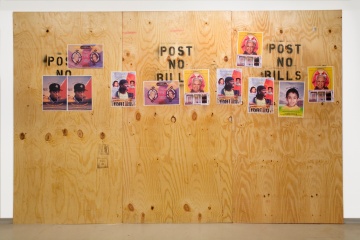
Brittni Ann Harvey, Harry Gould Harvey IV, Alex Ito, Rajkamal Kahlon, Dinh Q. Lê, Daniel T. Gaitor-Lomack, Carlos Motta, Carlos Reyes, Dread Scott, Astrid Terrazas, Chiffon Thomas, Faith Wilding
Recovery
September 10, 2021 - September 10, 2021
P·P·O·W is pleased to present RECOVERY, a group exhibition exploring art as a critical gesture towards collective resistance and remembrance. Acting as individual altar spaces, the works presented in this exhibition form commemorative sites to recover knowledge, provide proof, overcome loss, and contain memories.
Unearthing realities buried beneath layers of distorted visual understandings of historic representation, RECOVERY focuses on the notion of “insurgent commemoration”, defined by social justice scholar Roger Simon as “attempts to construct and engage representations that rub taken-for-granted history against the grain so as to revitalize and rearticulate what one sees as desirable and necessary for an open, just and life-sustaining future.” Forming alternative monuments for the living, RECOVERY gives a diverse range of narratives a voice, a platform and a meeting place. Building upon P·P·O·W’s rich programmatic history, RECOVERY brings together new works by gallery artists Dinh Q. Lê, Carlos Motta, and Chiffon Thomas along with Dread Scott, Faith Wilding, Carlos Reyes, Harry Gould Harvey IV, Brittni Ann Harvey, Daniel T. Gaitor-Lomack, Rajkamal Kahlon, Alex Ito, and Astrid Terrazas.
Together, the works exhibited in RECOVERY transform the gallery into both a devotional and construction site; an architectural space that is simultaneously coming apart and falling together. With three new psychologically charged sculptures, Chiffon Thomas displays their emblematic resourcefulness, utilizing materials such as concrete, rocks, nails, rebar wire, and wooden planks. Painted in white and emanating light, one of Thomas’ works will be suspended by an electrical lift at specific times throughout the day, acting as a kind of lighthouse, watchtower, or guiding phantom. In another spectral installation, Never Forget, Never Forgive: They Left Us to Die (2006), Dread Scott memorializes individuals killed by hurricane Katrina. Destroyed and remade whenever exhibited, the wheat-pasted posters on plywood panels with “Post No Bills” stenciled overtop detail how each of the remembered souls lived and died and are based on “martyr” posters of Palestinians killed by Israel pasted all over Palestine. Bearing witness to yet another facet of American life, Carlos Reyes’ saltwaterfarm serves as a monolith of residue. Comprised of 5,264 plastic egg crates, hollowed out chicken eggs, and industrial sand, Reyes’ towering translucent structure confronts the repetition, accumulation, and constraint of our society.
Building upon the ecological corrosion hinted at in Reyes’ work, pioneering eco-feminist Faith Wilding’s papyrus scrolls address the environmental deterioration in her lifetime, specifically in South America and her native Paraguay. Recording recent on-the-ground research into her birth country’s ongoing ecological crises, Wilding documents in watercolor, gold leaf, and handwritten ink, the metamorphosis of the natural world through human intervention and destruction. Similarly preserving ancient and ancestral ties, Dinh Q. Lê utilizes a traditional Vietnamese mat weaving technique learned from his aunt in his ongoing Monuments & Memorials series. Presenting a new photographic weaving, the artist combines an image of Tou Sleng (S-21) High School in Cambodia which was turned into torture center by the Khmer Rouge from 1975 to 1979, now a memorial museum, with a wall carving of the 10th century Cambodian Temple, Banteay Srey, now considered a monument. Using photography as both a technology for image making and an apparatus for distributing ideological narratives, Dinh Q. Lê reveals the failings of individual memory and collective perceptions.
In this critical time of re-evaluation, RECOVERY explores questions of how to inhabit space with renewed urgency. Through the process of art-making, we record, recount, and recover previously silenced truths that the essentialism and prejudices of visual politics have not been able to suppress.
Ann Agee
Madonnas and Hand Warmers
June 18, 2021 - July 16, 2021
P·P·O·W is pleased to present Madonnas and Hand Warmers, Ann Agee’s third solo exhibition with the gallery.
Showcasing the latest wares from the “Agee Manufacturing Company”, the fictitious enterprise that has motivated Agee’s three-decade career in ceramics, this tour de force exhibition will be comprised of more than one hundred unique
works that form two elaborate series of aesthetically and materially diverse sculptures. Alongside Kathy Butterly, Arlene
Shechet, and Annabeth Rosen, Agee is a leading member in a pioneering generation of feminist ceramicists. Since her
residency at the Kohler Arts Center in 1991, Agee’s practice has focused on replicating objects by hand, a process
employed to simulate mass production and engage ambiguous delineations between fine art, design, and craft; histories
of cultural appropriation and exchange; and the range of women’s lived experiences.
Inspired by late-17th and early-18th century Italian folk salt cellars in the collection of the Davanzati Palace in Florence,
Agee’s series Madonnas of the Girl Child depicts women and girls. Made from a variety of clays, formed with different
techniques, modeled in myriad sizes, glazed in numerous patterns, and fired in multiple kilns and at various
temperatures, these sculptures realistically or abstractly engage motifs of the divine infant. Unlike the ubiquitous
invocations of the Christ Child, all Agee’s offspring are female. Whether being breastfed, cradled, or corralled, these
girls are held up by their mothers and endowed with aptitude and virtue, regardless of their appearance. The sheer
panoply on view will showcase Agee’s mastery of the medium and her delight in experimentation.
Agee’s figurative sculptures will be complimented by her ongoing series of Hand Warmers, which she began in 2016.
Also inspired by Italian folk pottery, these vessels reference footwear and were historically meant to be filled with hot
water and clasped to warm one’s hands. When such objects were in fashion, Florence was plagued by violence and
upper-class women lived most of their lives in chilly palaces, resigned to pursuing the arts or domestic labor. Preceding
the Madonna of the Girl Child series, Hand Warmers exemplifies Agee’s deft technical skill; sophisticated synthetization
of cultural histories; and ingenuity with color, pattern, and form.
Each of Agee’s sculptures bears some text – “Agee Manufacturing Co.”, “Agee MFG”, or simply “Ann’s” -- a signature cum-logo that dates to Agee’s earliest works, including her Lake Michigan Bathroom, 1994. Rendered in enamel overglaze or in red or black slip, this brand creates the impression that each work is a multiple and that another size or a
different color could be fabricated back at the factory. Madonnas and Hand Warmers parodies an object’s trajectory
in cultural status from utilitarian commodity to rarefied artifact, placing Agee’s practice in the boundary-defying
traditions of Claes Oldenburg, Ken Price and Betty Woodman.
Ann Agee (b. 1959) lives and works in Brooklyn, NY. She earned her BFA from The Cooper Union School of Art in 1981 and her MFA from the Yale School of Art in 1986. Her work has been included in notable group exhibitions, including: Bad Girls (1994), The New Museum, NY; Dirt on Delight (2009), Institute of Contemporary Art, PA and the Walker Art Center, MN; and Conversations in Clay (2008), Katonah Art Museum, NY. She has received a John Simon Guggenheim Fellowship, The Louis Comfort Tiffany Foundation Award, and a National Endowment for the Arts Fellowship, among others. Her works are included in the permanent collection of notable institutions including The
Brooklyn Museum of Art, NY; The Philadelphia Museum of Art, PA; The RISD Art Museum, RI; The Los Angeles County Museum of Art, CA; The Henry Art Museum in Seattle, WA; The Kohler Art Center in Sheboygan, WI; and The Museum
of Contemporary Art in Miami, FL.
Martin Wong & Aaron Gilbert
1981-2021
April 2, 2021 - May 1, 2021
P·P·O·W is pleased to present 1981–2021, a two-person exhibition featuring the paintings of Brooklyn-based artist Aaron Gilbert and the late Chinese-American painter Martin Wong.
Guadalupe Maravilla
Seven Ancestral Stomachs
February 26, 2021 - March 27, 2021
P·P·O·W is pleased to present Guadalupe Maravilla’s Seven Ancestral Stomachs, the artist’s first solo presentation with the gallery. Combining sculpture, painting, performative acts, and installation, Maravilla grounds his transdisciplinary practice in activism and healing. For Maravilla, his own life story is his primary material.
Maravilla was part of the first wave of unaccompanied, undocumented children to arrive at the United States border in the 1980s as a result of the Salvadoran Civil War. While Maravilla emigrated at the age of eight, he became a U.S. citizen at the age of 26. Yet it was not until his recovery from colon cancer in 2013 that he felt the urgency to speak out about the struggles so many undocumented immigrants and their families face. By tracing his migration history and healing journey, Maravilla explores how the trauma undocumented immigrants experience physically manifests in the body. Reflecting upon his own battle with cancer, which began in his gut, as well as that of members of his family, Maravilla examines how genetic trauma manifests in the body over generations. Throughout the many teachings Maravilla experienced in his healing process, one notion kept returning – if one cleanses properly, they will heal seven generations back and seven generations forward.
Discovering sound therapy during his cancer radiation treatment, Maravilla has since developed a series of vertical, large-scale, free-standing sculptures, titled Disease Throwers. Functioning as headdresses, instruments, and shrines, the towering sculptures serve as symbols of renewal, generating vibrational sound from gongs. Described by Maravilla as “healing machines”, the structures incorporate materials collected from sites across Central America, such as anatomical models, toys, sacred objects, and sonic instruments including conch shells and flutes.
In addition to Disease Throwers, Maravilla will unveil a new series of wall sculptures. The exhibition’s eponymous seven twisting gourds with extending talons embody the seven stomachs of the artist’s ancestors. Surrounding the walls of the Seven Ancestral Stomachs is Maravilla’s reinterpretation of the popular Salvadorian children’s game, Tripa Chuca or “Dirty Guts,” in which two players take turns drawing lines that never intersect. Over the course of Maravilla’s more than two-month journey to the U.S., Tripa Chuca became a survival tool. For Seven Ancestral Stomachs, Maravilla has invited an undocumented person to collaborate with him on the Tripa Chuca mural in order to create a mapping between two displaced people on the walls of the gallery.
Furthering this investigation of various curative approaches, Maravilla will also present a series of retablos chronicling his healing journey. Originating in Medieval Spain, retablos are small devotional paintings, traditionally used in Mexican and Central American cultures to honor and celebrate the miracles of everyday life. Sending detailed digital sketches to a four-generation retablo painter he met in Mexico while retracing his migration route, Maravilla’s personalization of these votive offerings exemplifies his dedication to supporting a micro-economy through his artistic practice. Rather than making these paintings himself, Maravilla’s choice to collaborate expands the cross-cultural exchange of his practice and helps preserve the tradition of retablo painting in Mexico.
Guadalupe Maravilla (b. 1976) currently lives in Brooklyn, New York. He received his BFA from the School of Visual Arts, and his MFA from Hunter College in New York. His work is in the permanent collections of the Museum of Modern Art, New York; the Whitney Museum of American Art, New York; Museo Nacional Centro de Arte Reina Sofía, Madrid; and the Institute of Contemporary Art, Miami. Additionally, he has performed and presented his work at the Whitney Museum of American Art, New York; the Metropolitan Museum of Art, New York; the Institute of Contemporary Art, Miami, Florida; Queens Museum, New York; The Bronx Museum of the Arts, New York; El Museo del Barrio, New York; Museum of Art of El Salvador, San Salvador; X Central American Biennial, Costa Rica; Performa 11, New York; Performa 13, New York;, Shelly & Donald Rubin Foundation, New York; the Drawing Center, New York; SITE Santa Fe, New Mexico; the Moody Center for the Arts at Rice University, Houston, Texas; and the Contemporary Art Museum St. Louis, Missouri, among others.
Maravilla has received numerous awards and fellowships including a Guggenheim Foundation Fellowship, 2019; Soros Fellowship: Art Migration and Public Space, 2019; MAP Fund Grant, 2019; Franklin Furnace Fund, 2018; Virginia Museum of Fine Arts Fellowship, 2018; Art Matters Fellowship, 2017; Creative Capital Grant, 2016; Joan Mitchell Emerging Artist Grant, 2016; The Robert Mapplethorpe Foundation Award 2003, among others. He has also completed residencies with the Lower Manhattan Cultural Council, New York; SOMA, Mexico City; Skowhegan School of Painting & Sculpture, Maine; and the Drawing Center, New York.

 Back to all Member Galleries
Back to all Member Galleries


